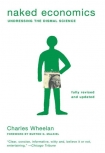Naked Economics by Wheelan, Charles (spanish books to read .txt) 📕

Read free book «Naked Economics by Wheelan, Charles (spanish books to read .txt) 📕» - read online or download for free at americanlibrarybooks.com
Read book online «Naked Economics by Wheelan, Charles (spanish books to read .txt) 📕». Author - Wheelan, Charles
Some entry barriers are more subtle. The airline industry is far less competitive than it appears to be. You and some college friends could start a new airline relatively easily; the problem is that you wouldn’t be able to land your planes anywhere. There are a limited number of gate spaces available at most airports, and they tend to be controlled by the big guys. At Chicago’s O’Hare Airport, one of the world’s biggest and busiest airports, American and United control some 80 percent of all the gates.6 Or consider a different kind of entry barrier that has become highly relevant in the Internet age: network effects. The basic idea of a network effect is that the value of some goods rises with the number of other people using them. I don’t think Microsoft Word is particularly impressive software, but I own it anyway because I spend my days e-mailing documents to people who do like Word (or at least they use it). It would be very difficult to introduce a rival word-processing package—no matter how good the features or how low the price—as long as most of the world is using Word.
Meanwhile, firms are not just choosing what goods or services to produce but also how to produce them. I will never forget stepping off a plane in Kathmandu; the first thing I saw was a team of men squatting on their haunches as they cut the airport grass by hand with sickles. Labor is cheap in Nepal; lawn mowers are very expensive. The opposite is true in the United States, which is why we don’t see many teams of laborers using sickles. It is also why we have ATMs and self-service gas stations and those terribly annoying phone trees (“If you are now frustrated to the point of violence, please press the pound key”). All are cases where firms have automated jobs that used to be done by living beings. After all, one way to raise profits is by lowering the cost of production. That may mean laying off twenty thousand workers or building a plant in Vietnam instead of Colorado.
Firms, like consumers, face a staggering array of complex choices. Again, the guiding principle is relatively simple: What is going to make the firm the most money in the long run?
All of which brings us to the point where producers meet consumers. How much are you going to pay for that doggie in the window? Introductory economics has a very simple answer: the market price. This is that whole supply and demand thing. The price will settle at the point where the number of dogs for sale exactly matches the number of dogs that consumers want to buy. If there are more potential pet owners than dogs available, then the price of dogs will go up. Some consumers will then decide to buy ferrets instead, and some pet shops will be induced by the prospect of higher profits to offer more dogs for sale. Eventually the supply of dogs will match the demand. Remarkably, some markets actually work this way. If I choose to sell a hundred shares of Microsoft on the NASDAQ, I have no choice but to accept the “market price,” which is simply the price at which the number of Microsoft shares for sale on the exchange exactly equals the number of shares that buyers would like to purchase.
Most markets do not look quite so much like the textbooks. There is not a “market price” for Gap sweatshirts that changes by the minute depending on the supply and demand of reasonably priced outerwear. Instead, the Gap, like most other firms, has some degree of market power, which means very simply that the Gap has some control over what it can charge. The Gap could sell sweatshirts for $9.99, eking out a razor-thin profit on each. Or it could sell far fewer sweatshirts for $29.99, but make a hefty profit on each. If you were in the mood to do calculus at the moment, or I had any interest in writing about it, then we would find the profit-maximizing price right now. I’m pretty sure I had to do it on a final exam once. The basic point is that the Gap will attempt to pick a price that leads to the quantity of sales that earn the company the most money. The marketing executives may err either way: They may underprice the items, in which case they will sell out; or they may overprice the items, in which case they will have a warehouse full of sweatshirts.
Actually, there is another option. A firm can attempt to sell the same item to different people at different prices. (The fancy name is “price discrimination.”) The next time you are on an airplane, try this experiment: Ask the person next to you how much he or she paid for the ticket. It’s probably not what you paid; it may not even be close. You are sitting on the same plane, traveling to the same destination, eating the same peanuts—yet the prices you and your row mate paid for your tickets may not even have the same number of digits.
The basic challenge for the airline industry is to separate business travelers, who are willing to pay a great deal for a ticket, from pleasure travelers, who are on tighter budgets. If an airline sells every ticket at the same price, the company will leave money on the table no matter what price it chooses. A business traveler may be willing to pay $1,800 to fly round trip from Chicago to San Francisco; someone flying to cousin Irv’s wedding will shell out no more than $250. If the airline charges the high fare, it will lose all of its pleasure travelers. If it charges the low fare, it will lose all the profits that business





Comments (0)